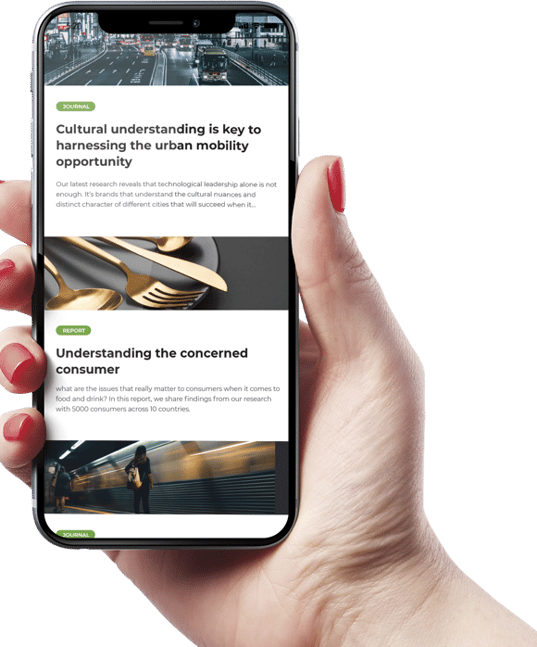They don’t fit into a neat generational box, yet they are shaping the future of commerce, content, and connectivity. Meet Gen C – Generation Connected, a powerful psychographic group that defies traditional demographics. Unlike millennials, Gen X, or Gen Z, they aren’t defined by birth years but by behaviour: always-on, digitally fluent, and community-driven.
For brands, Gen C is both an opportunity and a challenge. They consume, create, and curate content with the same intensity. They expect seamless digital experiences, hyper-personalised interactions, and authentic engagement, not just advertising. The old marketing playbook doesn’t work anymore. This generation of connected consumers trusts people over logos, conversations over campaigns, and social proof over brand messaging.
Fail to meet their expectations, and they’ll move on in seconds. Get it right, and they’ll be your most loyal advocates, driving sales, amplifying your brand, and influencing others.
So, who exactly is Gen C, and what do brands need to know to connect with them? Let’s break it down.
What Defines Gen C? A psychographic Shift beyond Age Groups
Gen C isn’t a demographic, it’s a mindset. They are the connected consumers, a group shaped by digital behaviours rather than conventional generational divides. Whether they’re 16 or 60, they share a common DNA: hyper-connected, content-driven, and community-focused.
Unlike traditional generations, Gen C doesn’t passively consume media; they shape it. They create TikTok trends, spark viral conversations, and turn niche products into overnight sensations. They move seamlessly across devices, platforms, and experiences, demanding instant access, real-time interactions, and highly personalised content.
But their defining trait? They trust people over institutions. Influencers, online reviews, and peer recommendations hold more weight than corporate messaging. Traditional ads fall flat; authenticity and relevance win every time.
For brands, this means a fundamental shift: marketing to Gen C isn’t about broadcasting; it’s about engaging. It’s about being part of their ecosystem, earning their trust, and delivering value beyond the product. Anything less, and they’ll swipe away without a second thought.
The DNA of Gen C – How They Consume, Create, and Influence
Gen C doesn’t just consume content—they shape the digital world. Every post, review, and share is an extension of their identity. They are not passive audiences; they are creators, curators, and critics who expect brands to meet them on their terms.
Hyper-Personalisation is Their Standard
Gen C has no patience for generic marketing. They expect AI-driven recommendations, interactive content, and frictionless transactions tailored to their preferences. Netflix knows what they’ll binge next. Spotify builds playlists based on their mood. Amazon anticipates their next purchase. If a brand doesn’t offer this level of personalisation, they’ll find one that does.
From Consumers to Creators
For Gen C, content is currency. They don’t just watch videos; they produce them. TikTok trends, YouTube vlogs, Instagram reels – they create, share, and remix content at scale. They influence what’s cool, what sells, and what goes viral. A single review or unboxing video can make or break a brand.
Community-Driven Commerce
This generation trusts real people over brand messaging. They seek recommendations from Reddit, Discord, and micro-influencers, not corporate ads. They are more likely to buy a product shared by a trusted friend than one promoted by a celebrity. Social proof is their decision-making engine.
According to a Nielsen study, 92% of consumers trust recommendations from friends and family over traditional advertising.
The Death of Passive Consumption
They multitask across devices, skipping ads in seconds. They crave interactive experiences like live shopping, AR try-ons, and direct brand engagement. Static content is dead. Brands that fail to create immersive, engaging experiences will be left behind.
For brands, this means rethinking the traditional marketing funnel. Gen C doesn’t just want products; they want experiences, authenticity, and a reason to engage. If a brand doesn’t deliver, they’ll move on—fast.
Case Study: CeraVe’s Digital Marketing Success
CeraVe, a skincare brand developed by dermatologists, has adeptly navigated the Gen C terrain through innovative marketing strategies emphasising authenticity, community engagement, and digital fluency. Their approach offers a compelling case study on connecting with the connected consumer.
Strategic Influencer Partnerships
Image credit: The Guardian
CeraVe’s collaboration with skincare influencer Hyram Yarbro exemplifies effective engagement with Gen C. Known for his candid and educational content, Yarbro’s genuine endorsement of CeraVe products, particularly their cleansers and moisturizers, resonated with his audience. This partnership not only enhanced CeraVe’s credibility but also significantly increased its visibility among digitally savvy consumers.
Innovative Campaigns
 Image Credit: PRN
Image Credit: PRN
In a bold move, CeraVe launched the “Michael CeraVe” campaign during Super Bowl LVIII. The campaign played on the phonetic similarity between the brand’s name and actor Michael Cera, creating a month-long conspiracy theory that Cera was behind the brand. This narrative was amplified by 450 influencers, resulting in 15.4 billion earned impressions before the official commercial aired, revealing the truth. The campaign not only garnered widespread attention but also led to a 25% increase in sales.
Educational Content and Community Engagement
CeraVe has also focused on creating educational content that demystifies skincare, aligning with Gen C’s desire for informative and valuable information. By partnering with dermatologists and leveraging social platforms, CeraVe provides content that educates consumers about skincare routines and the science behind their products. This approach has solidified CeraVe’s position as a trusted brand among Generation C.
CeraVe’s approach highlights the importance of understanding and engaging with the connected consumer on their terms.
The Connected Consumer Economy and How Gen C is Reshaping Business
Gen C is dismantling traditional business models. They demand seamless digital experiences, personalised engagement, and brands that move as fast as they do. The old rules of loyalty, advertising, and customer retention no longer apply.
Seamless Integration is Non-Negotiable
Gen C expects frictionless transactions across devices and platforms. A slow-loading website, a clunky checkout process, or a lack of mobile optimisation is enough to lose them. They move effortlessly between social media, e-commerce, and real-world interactions, expecting brands to provide a consistent, integrated experience across all touchpoints. Speed, convenience, and omnichannel accessibility define their expectations.
According to Google’s Consumer Insights Report, 53% of mobile users abandon sites that take more than three seconds to load, a critical statistic for brands targeting Gen C.
Loyalty is Transactional
Gen C does not pledge long-term brand loyalty, at least not in the traditional sense. Instead, they assess value in real-time. Subscription models, gamified loyalty programs, and membership-based communities are replacing outdated customer retention tactics. If a competitor offers a better, faster, or more relevant experience, they will switch instantly.
Nike’s SNKRS app is a powerful example of community-driven loyalty. It doesn’t just sell sneakers; it creates an interactive buying experience featuring exclusive drops, live events, and direct engagement with the brand. This strategy builds a sense of exclusivity and keeps Gen C engaged beyond just transactions.
 Image Credit: Nike
Image Credit: NikeThe Privacy Paradox – Balancing Personalisation and Trust with Gen C
Gen C craves hyper-personalisation but remains sceptical of how brands use their data. Transparency is non-negotiable. Companies that fail to articulate how they handle personal information risk losing trust and engagement.
A Cisco Consumer Privacy Survey found that 81% of consumers feel they have little control over how their data is collected and used.
Brands that implement ethical data practices, clear opt-in policies, and privacy-centric marketing strategies will gain a competitive advantage.
This shift requires brands to rethink how they operate. Traditional marketing tactics like aggressive advertising, mass email campaigns, and outdated loyalty programs are no longer enough. Gen C has reset the playing field, and brands must build agile, data-driven, and consumer-first strategies that evolve in real time.
How Brands Can Win Over Generation C
Reaching Gen C is not about broadcasting messages – it’s about earning relevance in their digital ecosystem. They don’t just buy products; they buy into experiences, communities, and values. Brands that understand this shift can turn them into engaged advocates.
Be Everywhere, Seamlessly
Gen C moves across platforms without friction. They might discover a brand on TikTok, research it through Reddit, and purchase through a mobile app. A fragmented customer journey is a deal-breaker. To keep pace, brands must integrate social commerce, AI-driven recommendations, and one-click transactions.
A Meta study revealed that 57% of Gen Z and millennials discover new brands through social media ads and influencer content. For Gen C, this discovery process is even more dynamic, involving interactive content, live shopping, and peer recommendations.
Think Community-First
Traditional advertising falls flat with this audience. Peer validation, micro-influencers, and real-time interactions carry more weight than polished brand messaging. Live shopping events, interactive Q&As, and organic brand storytelling drive engagement. The more participatory the experience, the stronger the connection.
Offer Value-Driven Engagement
Gen C expects brands to deliver more than just products. Content must be educational, entertaining, or problem-solving – ideally, all three. They engage with brands that help them learn, create, or improve their digital lives. Brands that focus solely on selling risk becoming irrelevant.
Duolingo, the language-learning app, leverages gamification, humour, and micro-content to engage users. Rather than simply selling language courses, it creates viral social media moments and personalised learning streaks that make users return daily. This approach builds loyalty through experience rather than transactions.

Image Credit: UX Design
Leverage Micro-Influencers and User-Generated Content
Celebrity endorsements are losing impact. Instead, Gen C trusts real people, like content creators with niche influence who feel authentic. Encouraging brand advocacy through user-generated content not only builds credibility but also fuels organic reach.
A HubSpot report found that 79% of consumers say user-generated content highly impacts purchasing decisions.
For Gen C, this influence is even stronger as they seek out honest reviews, behind-the-scenes content, and real customer experiences.
For brands, the key to winning Gen C is participation, not persuasion. They don’t want to be marketed to; they want to be part of the conversation. Brands that enable interaction, authenticity, and community will thrive in this new era of consumer engagement.
The Future of Gen C – What’s Next for Connected Consumers?
Gen C is not a trend. They are the architects of a digital-first economy where immediacy, personalisation, and participation define success. As technology advances, their expectations will only grow sharper. Brands that fail to evolve will become obsolete.
AI-Driven Digital Experiences Will Redefine Engagement
AI will shape how Gen C interacts with brands, from predictive shopping assistants to hyper-personalised content feeds. Chatbots will no longer be basic customer service tools. They will act as intelligent brand representatives, anticipating needs and offering real-time solutions.
Decentralised Platforms Will Shift Control
The dominance of centralised social media platforms is fading. Gen C is exploring blockchain-based communities, private Discord servers, and creator-driven ecosystems where they control data and interactions. Brands must rethink their reliance on traditional platforms and embrace new digital spaces.
The End of Passive Brand-Consumer Relationships
Gen C does not want to be marketed to; they want to co-create. Future-forward brands will integrate consumers into product development, decision-making, and storytelling. Interactive campaigns, community-driven product launches, and immersive digital experiences will become the standard.
From Consumers to Digital Citizens
Gen C expects brands to meet their digital demands and align with their values. Purpose-driven marketing, ethical data usage, and authentic connections determine which brands earn long-term relevance.
The brands that thrive in the Gen C era will not be the ones with the biggest advertising budgets. They will be the ones that understand, adapt, and integrate seamlessly into the connected world Gen C is shaping.
Why Brands Must Adapt Now
This new generation of connected consumers has rewritten the rules of consumer engagement. They are not a passive audience waiting to be sold to – they are active participants shaping the marketplace. Their expectations for seamless digital experiences, real-time interaction, and community-driven commerce demand a fundamental shift in how brands operate.
For brands, the message is clear: adapt or become irrelevant. Traditional marketing strategies built on broad demographics and static messaging no longer work. Winning in the Gen C economy requires brands to be dynamic, responsive, and embedded in their audience’s digital culture.
This shift has already happened. The brands that recognise Gen C’s influence and invest in hyper-personalised engagement, trust-driven relationships, and participatory experiences will lead the next era of consumer marketing. Those that fail to evolve will watch as their relevance fades.
The connected consumer revolution is here. The only question is: is your brand ready for it?




